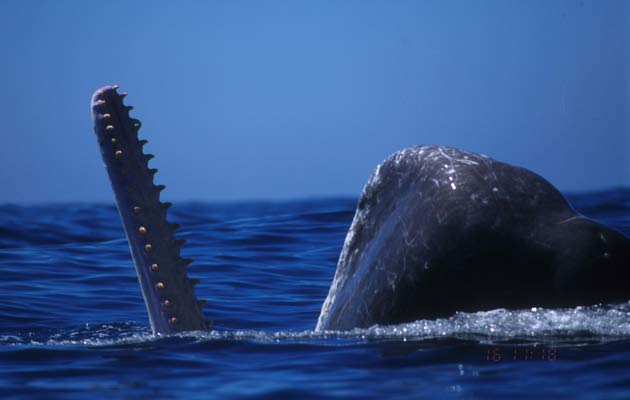Deep Mystery: How Huge Whales Hunt Jumbo Squid

In the cold, dark abyss of the Pacific lurk thousands of aptly named jumbo squid (Dosidicus gigas), aggressive carnivores up to six feet long and 100 pounds nicknamed "red devils" by fishermen.
Still, even these creatures can become prey to leviathans. The largest predators in the world, sperm whales, have a voracious appetite for squid, devouring perhaps 220 billion pounds a year or more, roughly equivalent to the entire annual harvest of all the commercial fisheries on Earth.
Yet how sperm whales hunt jumbo squid has remained a mystery.
Now, by electronically tagging both to peer at their habits up to thousands of feet underwater, scientists are discovering a deep sea version of "out of the frying pan and into the fire," with squid that flee the relative heat of surface waters potentially finding themselves in the maws of whales.
Tacos and tagging
Marine scientist William Gilly at Stanford University and his colleagues were tagging jumbo squid in the Gulf of California, also called the Sea of Cortez. By good luck, they found marine biologist Randall Davis of Texas A&M University in Galveston and his collaborators tagging sperm whales nearby.
After a dinner of tacos, beer and rum on Davis and his colleagues' research vessel, the scientists decided to work together to be the first to electronically track deep sea predators and their prey simultaneously.
Sign up for the Live Science daily newsletter now
Get the world’s most fascinating discoveries delivered straight to your inbox.
"It's very rare to find a place like the Gulf of California where you can actually see sperm whales together with their prey," Davis said. "I can't think of another place in the world where this would be possible."
Squid behavior
The sperm whale [image] remains a challenge for scientists to research today. At the same time, little remains known about the behavior of jumbo squid in the wild.
"Adult sperm whales can stay underwater for more than an hour, but nobody knows exactly what they're doing down there," Davis said.
"It was only a couple of years ago that we discovered an area in the central Gulf of California where spawning and mating of these animals probably take place," Gilly said. The jumbo squid is found only in Pacific waters, ranging from Chile to Alaska.
Davis and his colleagues searched for whales in their research vessel during the day by listening for the clicks they made with hydrophones, or underwater microphones. Once they got close enough to a whale at the surface, the team used a 25-foot carbon fiber pole to stick satellite-linked tags into the skin of five sperm whales.
"The moments before tagging are perhaps the most exciting," Davis said. "You can hear the whale breathing, and at any moment it may descend."
Gilly and his colleagues tagged three jumbo squid at night [image], either renting their own boats or going out with fishermen from Santa Rosalia, a coastal Baja California town that is the center of Mexico's jumbo squid fishery. The tags, which fit under squid fins, were designed to detach after two or three weeks and float to the surface and then transmit stored data to orbiting satellites.
A popular depth
During the day, electronic tags revealed tagged squid spent about three-quarters of their time at depths ranging from 600 to 1,300 feet, but at night, they spent at least half their time in shallower waters above 600 feet.
One likely explanation for this rise at night is that they were following prey such as bioluminescent lanternfish and krill and other crustaceans. Such small marine prey species typically migrate toward the surface after dusk to feed on phytoplankton, or photosynthetic sea life, and return to deeper waters during the day to escape tuna and other predators that rely on eyesight to hunt nearer the surface.
The electronics tags revealed whales spent three-quarters of their time ranging from 600 to 1,300 feet day and night, "whether squid are there or not," Davis said. "Perhaps it's the only way they can catch them, but no one has ever seen a sperm whale feeding in the wild, so nobody really knows how they capture their food."
Curiously, squid often made rapid nighttime dives from the surface to depths that whales frequent. Surface waters might stress the squid out, Gilly suggests, perhaps due to the heat, which at up to 82 degrees Fahrenheit is sweltering for squid, or due to the high oxygen content.
"We propose that jumbo squid are more susceptible to predation while they are recovering at depth immediately after a deep nighttime dive," Gilly said. The researchers detail their findings in the March 12 issue of the journal Marine Ecology Progress Series.
Future research can tag more whales and squid and follow them around the year," Davis said. "There's much about these animals that remain a mystery."
- First Videos of Deep-Sea Squid Reveal Aggressive Predator
- Elusive Giant Squid Finally Photographed
- Whales Set Deep-Diving Record
- All About Whales










